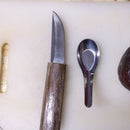Introduction: Small Carving Chisel
Here I will show how I crafted a handy little carving chisel.
materials used:
walnut hardwood, roughly 7/8" square and 4 3/4" long
2 3/4" long piece of 1/8" square W1 tool steel rod ( a length of 36" rod can yield 13 tools of this size)
5/8" dia copper water pipe, cut down to 1/4" for a ferrule
main tools used:
wood lathe + lathe chisels
hand file
mapp torch
butane torch
hand drill
sharpening stone + sand paper
Step 1: Making the Handle
First step was to establish the centers of my blank and to mark the handle diameter needed to affix the ferrule by simply tracing it inside and out on the end I wanted.
steps for shaping the handle:
1. knock off the square corner with a sharp roughing gouge
2. create a tenon down to the outside dia of the ferrule by using a parting tool
3. again using the roughing gouge, turn the rest of the handle down to the same dia of the 1st tenon
4. mark the length of the ferrule on the handle blank and turn that down to the inner dia of the pipe ( leave it a little larger otherwise the ferrule will be loose)
5. round the end of the handle then sand with progressive grits of sand paper
Step 2: Afixing the Ferrule
Next steps are pretty straight forward.
1. file a bevel on the handle tenon and countersink the end of the ferrule, this helps act as a guide when press fit
2. line everything up and tap the handle on the ferrule
Step 3: Making the Blade and Tempering
Time to make the blade.
steps were as followed:
1. mark and file an angle on the blade blank, ideally this should be around 15-22 degrees and as flat as possible
2. the blade was heated to a none magnetic temp with the mapp torch then quenched in water ( W in W1 indicates water hardening)
3. tempering aka reducing the brittle hardness of the steel
after the quench, a fine file should skate across the surface, this is an indication that the steel was successfully hardened but the catch is, its too hard and would otherwise break/ chip if used as is
the tempering process consists of cleaning the blade with sandpaper to expose bright steel, carefully heating it about 1 1/2" behind the blade and waiting for the colors to form
for a cutting tool I wanted a light to darker golden straw color as seen in the picture
Step 4: Assemble and Use
Last but not least, a hole was drilled in the handle to insert the blade, blade was then sharpened and tested out.
now I have a nice unique little chisel to serve me for years to come

Participated in the
Build a Tool Contest











